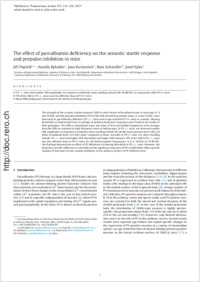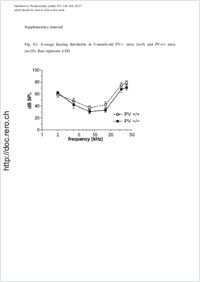The effect of parvalbumin deficiency on the acoustic startle response and prepulse inhibition in mice
- Popelář, Jiří Institute of Experimental Medicine, Academy of Sciences of the Czech Republic, Department of Auditory Neuroscience, Prague, Czech Republic
- Rybalko, Natalia Institute of Experimental Medicine, Academy of Sciences of the Czech Republic, Department of Auditory Neuroscience, Prague, Czech Republic
- Burianová, Jana Institute of Experimental Medicine, Academy of Sciences of the Czech Republic, Department of Auditory Neuroscience, Prague, Czech Republic
- Schwaller, Beat Anatomy, Department of Medicine, University of Fribourg, Switzerland
- Syka, Josef Institute of Experimental Medicine, Academy of Sciences of the Czech Republic, Department of Auditory Neuroscience, Prague, Czech Republic
-
11.10.2013
Published in:
- Neuroscience Letters. - 2013, vol. 553, p. 216–220
Parvalbumin
Acoustic startle reflex
Prepulse inhibition
Hearing threshold
Parvalbumin deficient mice
English
The strength of the acoustic startle response (ASR) to short bursts of broadband noise or tone pips (4, 8 and 16 kHz) and the prepulse inhibition (PPI) of the ASR elicited by prepulse tones (4, 8 and 16 kHz) were measured in parvalbumin-deficient (PV−/−) mice and in age-matched PV+/+ mice as controls. Hearing thresholds as determined from recordings of auditory brainstem responses were found to be similar in both genotypes. The ASRs to broadband noise and tones of low and middle frequencies were stronger than the ASRs in response to high-frequency tones in both groups. In PV−/− mice, we observed smaller ASR amplitudes in response to relatively weak startling stimuli (80–90 dB sound pressure level (SPL)) of either broadband noise or 8-kHz tones compared to those recorded in PV+/+ mice. For these startling stimuli, PV−/− mice had higher ASR thresholds and longer ASR latencies. PPI of the ASR in PV−/− mice was less effective than in PV+/+ mice, for all tested prepulse frequencies (4, 8 or 16 kHz) at 70 dB SPL. Our findings demonstrate no effect of PV deficiency on hearing thresholds in PV−/− mice. However, the frequency-specific differences in the ASR and the significant reduction of PPI of ASR likely reflect specific changes of neuronal circuits, mainly inhibitory, in the auditory centers in PV-deficient mice.
- Faculty
- Faculté des sciences et de médecine
- Department
- Département de Médecine
- Language
-
- English
- Classification
- Biological sciences
- License
-
License undefined
- Identifiers
-
- RERO DOC 209507
- DOI 10.1016/j.neulet.2013.08.042
- Persistent URL
- https://folia.unifr.ch/unifr/documents/303338
Other files
Statistics
Document views: 153
File downloads:
- pdf: 243
- Supplementary material: 141

